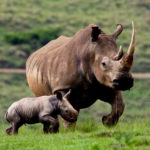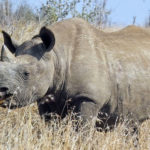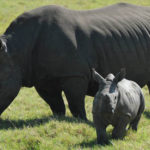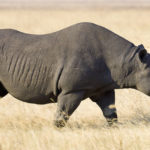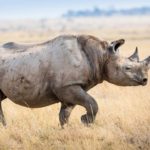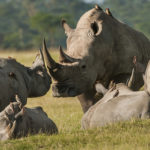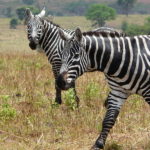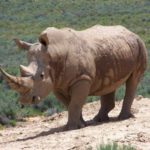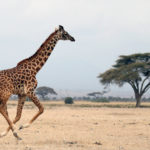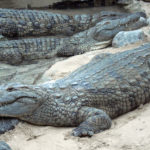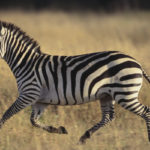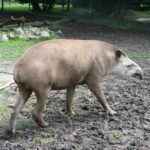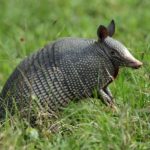Rhinos
 Rhinos are large animals, named so because of their peculiar horns, not located on the top of the head, like other horned animals, but at the end of the muzzle. Rhinos belong to the family of the Nosogorov Detachment of the Unguided Ungerns, thus they are relatives of horses, donkeys, zebras and tapirs. In the world, there are 5 species of these animals: Javanese, Sumatran, Indian, black and white rhinoceroses.
Rhinos are large animals, named so because of their peculiar horns, not located on the top of the head, like other horned animals, but at the end of the muzzle. Rhinos belong to the family of the Nosogorov Detachment of the Unguided Ungerns, thus they are relatives of horses, donkeys, zebras and tapirs. In the world, there are 5 species of these animals: Javanese, Sumatran, Indian, black and white rhinoceroses.
The constitution of these animals is heavy: a massive body, a powerful neck, a rounded croup, a large head, thick but short limbs – all these signs make the rhino look like a small tank. Their legs end not one (like horses), but three fingers, at the end of each there is a wide hoof. The tail is thin and comparatively short with a “donkey” tassel at the end. The skin is very thick and rough, on the even parts of the body is covered with shallow wrinkles and it seems granular. Asian species of rhinoceroses on the body are also deep folds, which makes it seem as if these animals are dressed in knightly armor.
The coat of rhinoceroses is reduced, in addition to the brush on the tail, the wool grows only on the edges of the ears. The exception is the Sumatran rhinoceros, whose whole body is covered with a rare brown wool. In general, these animals are painted monotonously in different shades of gray.
The horns of these animals have an unusual structure: they are formed not by bone or horny substance, as in horned cloven-hoofed animals, but by the finest layers of keratin. In fact, horns of rhinos consist of the same protein as hair or hooves. Despite the apparent fragility of such material, they are distinguished by their strength and hardness. Animals easily break their branches, and if necessary can deal a crushing blow to the enemy. Different kinds of rhinos can have one or two horns. If the horns are two, then the second is always smaller in size. The main horn can reach a length of 15-60 cm, the longest length recorded in a white rhinoceros was 1.58 m! With a height of 1.1-1.6 m in the shoulders, the mass of rhinoceroses can reach 2-5 tons, which is comparable to the weight of a young elephant.
African species of rhinos – black and white – inhabit dry woodlands and savannas, they are found all over the continent to the south of the Sahara. The area of the Indian rhino encompasses the Hindustan peninsula, this species prefers wet meadows and open river banks. Sumatran and Javanese rhinoceroses previously inhabited the vast expanses of Southeast Asia from India in the west, China in the north to the islands of the Malay and the Great Sunda archipelagos in the south. Now scattered populations of the first species can be found on the islands of Sumatra and Borneo, and the Javanese rhino is generally preserved only in the national park Ujung Kulon on the island of Java. Sumatran and Javanese rhinoceroses, unlike their relatives, like wooded areas and overgrown with thick vegetation marshes.
Asian species of rhinos always live alone, although sometimes there may be several animals in one section of the meadow at the same time. African rhinoceroses are more sociable, these species can form small herds of 3-15 individuals. Rhinoceroses, living alone, can tolerate drinking at the watering place, but they show intolerance towards their neighbors on their individual plots. The borders of the possessions they mark with urine or neat piles of litter. But the rhinoceroses from one flock, on the contrary, protect their own and even help wounded brethren.
The nature of rhinoceroses is a strange mixture of calm, stubbornness and explosive belligerence. During the grazing, they slowly move across the plain, not particularly interested in what is happening around. The reasons for this indifference to the world around us are large sizes (they have practically no enemies) and … short-sightedness. A man standing a rhinoceros can only notice from a distance of 30-35 m, so getting to him from the lee side is very simple. But these animals have excellent hearing and sense of smell, so these animals often sniff, and if the wind will bring them bad news, they immediately respond to the danger. Sensing the presence of an imaginary or real predator, the rhinoceros usually go off trot, developing a speed of 25-30 km / h.
But if he is injured or deprived of the opportunity to retreat, he becomes furious and becomes uncontrollable. The giant throws himself at his enemy at a speed of up to 50 km / h, while trampling a small animal or a person does not cost him anything, at that moment a bullet can stop him. It is noticed that in a similar way rhinoceroses react to elephants that exceed them in size. If the elephant is inexperienced, then embarks on a shameful flight, and if old and mighty, then it goes against the flying carcass. The battle of the two Titans ends pitifully for the stubborn rhino. Interestingly, the blinded rhinoceros well distinguish the silhouettes of herbivores (buffaloes, zebras, antelopes) and they never attack them by mistake.
